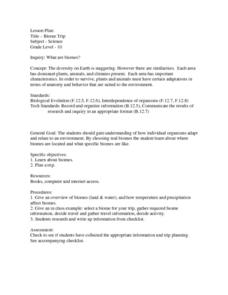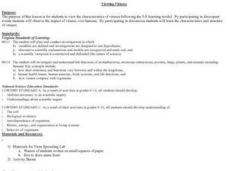Curated OER
The Watershed Quest
Students examine their connection to local watersheds. They describe the water cycle and list species living in their local watershed. They also draw a map of their community.
Curated OER
What Color is the Ocean?
Students view satellite pictures of the ocean, and discuss the presence of phytoplankton and the colors of the ocean. Students compare/contrast ocean satellite images with maps and globes, then color world maps to replicate the satellite...
Curated OER
Needs of Living Things
Students discuss and explore the needs of living things. They choose to create a slide show with captions, create a web showing the needs of one Organism using KidPix. or make picture book by hand or using Microsoft Publisher.
Curated OER
Soil Microbiology- Nitrogen cycle
Students take a virtual trip to a Catfish Aquaculture Pond and analyze soil bacteria to determine how many nitrogen cycle bacteria are present. They graph the number of colonies present and use data to determine ammonium levels in the soil.
Curated OER
Biome Trip
Tenth graders comprehed how individual organism adapt and relate to an environment. They investigate where biomes are located and what specific biomes are like. Pupils give examples of biomes (land and water), and how temperature and...
Curated OER
Prey or Pray? Could YOU Escape a Cheetah?
Tenth graders estimate the size of an adult cheetah by research and measurement of a picture. They determine the approximate distance and speed of the cheetah from a filmed chase and compare that to their own running speed.
Curated OER
Ecology and Ecosystem
Students are introduced to the concepts of ecology and ecosystems. In groups, they use the Internet to research one of six topics. They present their information to the class sharing the most interesting information they found. They...
Curated OER
Da Vinci's Renaissance
Students study the Renaissance through an examination of the life and accomplishments of Leonardo Da Vinci.
Curated OER
Look At Those Leaves!
Pupils observe, measure, and sort tree leaves. They examine leaves individually, in groups, and in relationship to the entire tree. Pupils take a walk outside for a "Leaf Walk." Students are each given a lunch size paper bag, so that...
Curated OER
The Sun: An Introduction
Students write entries in their Science Journals as they explore the Sun.
Curated OER
Blooming Thermometers
Students study phenology, or the study of climate change. They research the Japanese springtime festival of Hanami and plot and interpret average cherry blossom bloom date data from the past 1100 years.
Curated OER
Viewing Viruses
Students view the characteristics of viruses following the 5-E learning model. By participating in discrepant events Students observe the impact of viruses over humans. By participating in discussion students examine the characteristics...
Curated OER
Spring Awakenings
Young scholars observe changes in a selected tree bud/leaf during spring. They record changes in the bud/leaf using words, pictures and numbers. They understand that trees adapt to changes in temperature, light, and moisture by sprouting...
Curated OER
The Weather Classroom: Atmosphere
Students explore the planets and their atmospheres online. They write the story of "Goldilocks and the Nine Planets" to explain how each planet's atmosphere differs from Earth's. They design a viable life form.
Curated OER
Life in a Cup
Third graders make and maintain a mini terrarium. They keep a daily journal of what happens in their terrarium and record daily observations and measurements.
Curated OER
Raquel's Radishes
Sixth graders develop a reasonable hypothesis for a fictional science fair investigation. 'Raquel' is going to grow radishes and test for the best way to nourish them. They create a bar graph and write conclusions.
Curated OER
Adapted to Fire
Fourth graders explore forest species' adaptations to fire by participating in a scavenger hunt and mapping a burned forest. Students create maps and explore how indigenous species adapted to living with fire.
Curated OER
Hatching Brine shrimp
Second graders investigate the life cycle using brine shrimp as an example. They conduct observations by watching the shrimp hatch out of cysts. Students design simple experiment to structure an observation. The experiment is approved...
Curated OER
Cotton and Cabbage
High schoolers note how given traits could be achieved by selective breeding and by transgenesis. They identify different uses of GEO. Students recognize that the use of letters (Bt) before an organism's name means that the organism has...
Alabama Learning Exchange
Alex: Plants, Pigments and Colors
In this hands-on, inquiry based lesson students will see the role of pigments in the in the process of photosynthesis. Students will use the process of chromatography to separate plant pigments. Students will then see the function of...
Alabama Learning Exchange
Alex: Touch and Feel: Plant Adaptations
This introductory lesson centers on getting hands-on before getting drug into the vocabulary and nomenclature. In cooperative learning groups students will describe leaves in simple terms. Then, students will use various resources for...






















